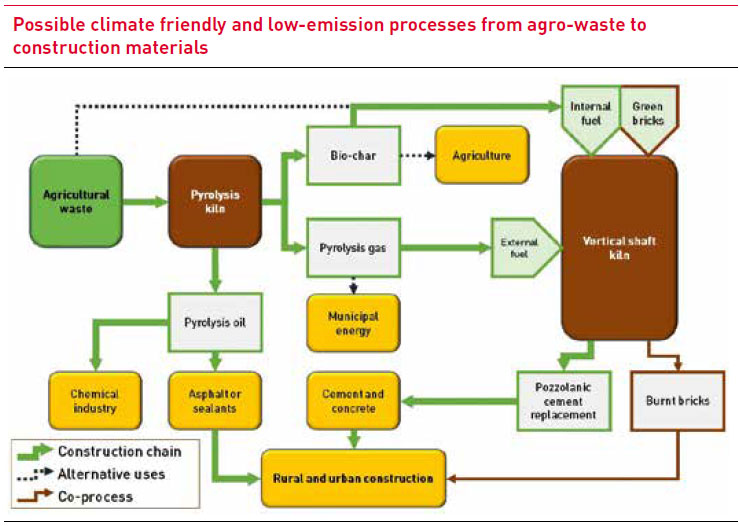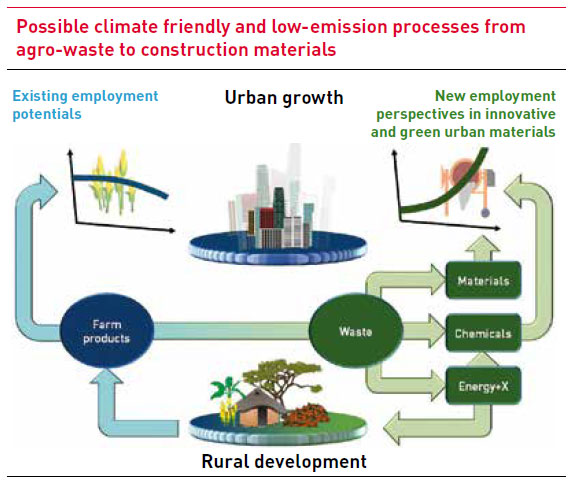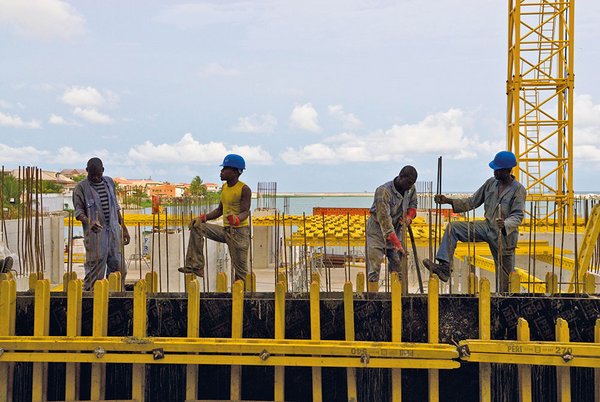Green urban development creates rural employment perspectives
The destiny of sub-Saharan Africa’s (SSA) urban areas will inevitably be determined by their surrounding rural areas. They provide the goods that are required and consumed in urban areas, such as food, energy, minerals and materials for production. With a growing urban population, more rural goods are required. Therefore, the low capacity for rural livelihood enhancement along with the dramatic urban growth is detrimental to sustainable socio-economic developments in Africa.
Average annual urban growth in sub-Saharan Africa is 4.13 per cent, with a 6.48 per cent maximum and a 0.14 per cent minimum for Equatorial Guinea and Mauritius, respectively. In contrast, average rural growth is only 1.95 per cent, with a 3.77 per cent maximum and a -0.81 per cent minimum for Niger and Gabon, respectively. Although the rural population is increasing in most countries of SSA, its growth relative to urban growth is dramatically smaller.
On average, the urban population grows 2.12 times faster than the rural population, and the decreasing livelihood potentials in rural areas are likely to increase this ratio in the future. Service, a typical urban business, grew by 12.17 per cent from 2000 to 2018, while the agricultural market dropped by 10.90 per cent in the same time. The better urban employment perspectives in SSA are also underpinned by a service employment growth of 26.91 per cent compared to a decrease of 14.16 per cent in agriculture. Furthermore, the income gap and the number of people below national poverty level are much higher in rural areas.
Making use of synergies between urban and rural development
Nevertheless, the better urban potentials do not always result in better living conditions. Approximately 60 per cent of SSA’s urban population live in low-income, disadvantaged settlements, with a maximum of 96 per cent in South Sudan and a minimum of 18 per cent in Zimbabwe. A recent workshop on children’s visions of their city of the future at the Star Kids Initiative in Mukuru estate in Nairobi, Kenya, clearly showed that the urban children dreamt of more space, plants and animals, which resembles a rural setting rather than an urban one. In contrast, a similar workshop with girls and young mothers at the Forward Step Organisation in rural Bagamoyo in Tanzania clearly showed that the major wishes of the female rural population were closer to an urban setting. The most important wishes addressed were infrastructure, water and energy supply, as well as short distances to services, health and educational facilities. In summary, from the perspective of their future dwellers, this means that cities should have more rural and villages more urban components.
Thus, instead of overdeveloping already urbanised areas, the development of rural areas becomes vital. The creation of rural employment perspectives and better livelihoods is key to a more balanced development of urban and rural areas. With the aforementioned limited development perspectives in the classical rural business areas, it becomes necessary to identify new perspectives, which lie in the synergies between urban growth and rural development.
Climate-friendly construction materials offer new income sources
The most relevant employment and business perspectives in growing African cities results from the sheer need for construction materials. Only 20 per cent of the urban structures that will have been installed by 2050 are already built. In return, this means 80 per cent of urban construction will take place over the course of the next 30 years. Although often considered as unpopular, concrete is the most feasible material for future cities. Compared to all other construction materials, it has the lowest carbon footprint and energy demand. In addition, it is the only resource on Earth that can meet the tremendous global demand.
In Africa, steel has to be imported, and timber is prohibitive in most countries because of already dramatic deforestation. And although building heights should generally be limited to save materials, building heights are per se limited with timber construction. However, given the tremendous amount of concrete required in the world, its binder cement alone is responsible for about ten per cent of the global carbon emissions. Future African urban concrete construction will significantly add up to this already high climate impact. In return, Africa also has more potential than any other region in the world to invent green and low carbon concrete innovation, by applying state-of-the-art knowledge and using local supplies in an innovative way.
In order to identify where urban construction can create rural development perspectives, it is important to understand typical rural economies. Agriculture usually accounts for about 60 to 80 per cent of the livelihoods. Mining is another major contributor. Retail, administration and social services are significantly less important. Therefore, the large branches should be focused on. With regard to potentials in mining, novel future perspectives lie in choosing clays that cannot be used for ceramics but can perform excellently as cement replacement after calcination.
However, one largely neglected available resource is agricultural waste materials, which can be converted into high-performance concrete constituents. The African continent provides about 60 per cent of the global unused arable land. Most agricultural waste from food production has a high content of organic residues. Although they cannot be used for food, they can still serve as water-reducing or robustness-enhancing admixture in concrete, and thus contribute to higher performance with less cement consumption. These agro-based organic admixtures can create new and local business opportunities by replacing crude oil-based agents, which today in Africa have to be imported at high prices.
While construction chemicals are a small and specialised market, cement is a high-volume market. Therefore, the most relevant resource is ashes from agricultural waste, which occurs in vast amounts and today is not used for other technologies. If agro-waste is burnt at temperatures between 600 and 800 °C, it often contains significant amounts of reactive silica and alumina oxides, and thus can replace Portland cement clinker in concrete by up to 30 per cent or more.
In order to make maximum use of the process, the burning of the ashes can be done in parallel to the burning of clay bricks or the energy can be used for food processing. An ideal process with a maximum yield of by-products and minimum carbon emissions can be obtained if the agro-waste goes through a pyrolysis process before being burnt to a reactive ash. This process produces pyrolysis gas (energy), pyrolysis oil (chemicals), as well as a bio-char that can be further processed as fertiliser or cement replacement. In order to prove the concept, a small-scale 2-stage pyrolysis plus kiln pilot plant was built recently on the campus of the University of Ghana within the context of the INFRACOST project, funded by Germany’s Federal Ministry of Education and Research (BMBF). An example of the larger scale coupled with a vertical shaft kiln technology is given in the Figure.

Wastes such as sugar cane bagasse, rice husks, cassava peels or palm kernel excellently qualify as green Portland cement clinker replacement. Normally, these wastes have no or low-value use today. However, as shown in the Figure on the left, by developing the right value chains in the urban construction business, formerly unused rural wastes can be converted into cement replacement materials, construction chemical, energy and precursors without creating additional competition. This way, rural farmers can significantly enhance their livelihoods and in parallel contribute to reduced emissions of climate gases.

Value chains based on cassava waste in Nigeria
Cassava is a staple food for over 500 million people in the world, and it represents a source of food for about 80 per cent of people in SSA. It is a cheap provider of carbohydrates that grows on marginal soil without complex processing. Besides food, cassava starch has also been established in paper, textile and pharmaceutical industries. Africa accounts for nearly 60 per cent of global production. With its 56 megatons per year, which is 35 per cent of the African and 20 per cent of the global production, Nigeria is the largest producer world-wide. Since cassava has relatively thick peels, the waste represents up to 20 per cent by mass of the tuber, which today creates large challenges of effective disposal. The peels do not qualify for livestock feeding, as they cannot be well digested and contain low protein. Typically, they are dumped in landfills, burnt uncontrolled, or just left to rot. This causes malodour and environmental pollution, and it requires plenty of space which could be made better use of. There is no significant value chain for the wastes to date, although they could be used entirely for high-performance urban construction materials. Firstly, the starch adhered to the peels can be dissolved and converted to a plasticising chemical admixture which has proven to have the capacity to reduce the water content in concrete to increase its strength. Secondly, the residual peels can be burnt, and the residual ashes can help replace cement in concrete in an environmentally friendly manner.
While the technical potential has been proven scientifically before, the socio-economic and climatic impacts are the topic of research within the Local-Care project, which was awarded the German African Innovation Incentive Award of the BMBF in 2018. Within the project, for the first time, a real structure made out of cassava-based concrete will be built in 2020 on the campus of the University of Lagos – an important matter, because research innovation needs tangible pilots in order to find acceptance in society.
In this project, a survey among 200 cassava processors in Nigeria indicated that 81 per cent were females, mostly between 20 and 50 years of age. Approximately 75 per cent only had primary education, and thus little potential to enhance their livelihoods. The revenues from the peels were marginal. Less than 20 per cent were sold. Hence, at least 80 per cent would be available for the cement and concrete industry, which could enhance the potentials for better livelihoods of the local producers significantly. Assuming that all available peels will be collected and used as sustainable cement replacement, this would translate to 2.5 to 5 per cent of the Nigerian cement market, or approximately 0.7 million tons of saved carbon emissions. Both peel ashes and starch can be used either on a small scale by formal or informal smallholders, or by the large cement industry, where the cassava peel ashes could be blended with cement to be sold in the national and international retail market. This would require complex waste collection infrastructure and homogenisation. Smallholder producers could directly use the ashes to reduce their cement in concrete for the local market, but unlike in the large-scale industry, more training and technical support would be required.
Obstacles and skill requirements
The biggest obstacle for the implementation of such green construction materials techniques is the societal misconception that agricultural waste products only qualify for low-end use. Furthermore, and despite the striking added values that can be created, new technologies are always accompanied by yet unknown challenges. Typical challenges arise from residues of fertilisers as well as scattering qualities and production volumes. These obstacles can be solved technically but require research and interdisciplinary competences.
Therefore, the knowledge has to be brought to the prospective rural decision-makers, who need a clear picture of the economic and societal potentials of agro-based construction materials markets. Despite new income sources, these markets also help to empower female farmers and create more independence, which is of utmost importance in the rural environments. At the same time, decision-makers need clear information about technical challenges and infrastructure that has to be established prior to implementation. This requires closer collaboration with academia and relevant disciplines such as civil and environmental engineering, economics, agriculture, materials and chemistry.
Seizing the opportunity
By creating novel value chains from agro-waste to construction materials, rural areas can significantly benefit from urban growth and contribute to greener and more sustainable construction in Africa. This can also be a potential to accelerate rural development, which in return would reduce the driving force for migration to cities. Since one-fit-all solutions for agro-waste value chains do not exist, best-practice solutions have to be developed individually, based on the local boundary framework. These must be worked out in close collaboration with local academic units, which are typically located in cities. Hence, the development of construction materials based on agro-waste offers a unique opportunity for business and knowledge transfer between rural and urban areas with mutual benefit, and with a highly positive impact on the global climate.
Wolfram Schmidt is a researcher at Germany’s Bundesanstalt für Materialforschung und -prüfung (BAM) in Berlin, Germany, with focus on sustainable construction materials. He has initiated several pan-African research and education collaborations.
Kolawole Adisa Olonade is a senior lecturer in civil engineering at the University of Lagos, Nigeria. He has been involved in various pan-African research collaboration schemes, and together with Wolfram Schmidt, he was awarded the German-African Innovation Incentive Award in 2018.
Nonkululeko Winnie Radebe is a 3rd year PhD student at the Karlsruhe Institute of Technology, Germany. She is working in the Institute for Technical Chemistry and Polymer Chemistry.
Faudhia Zando and Vincent Ssekamatte are initiators and chairpersons of the Forward Step Organization, an empowering and mentorship centre for girls and young mothers in Bagamoyo, Tanzania.
Contact: wolfram.schmidt@bam.de
Acknowledgements:
Parts of the presented works on kiln processes and cassava peel processing have been developed within the projects INFRACOST and Local-Care, respectively. The authors highly appreciate the funding provided by the German Federal Ministry of Education and Research in the schemes CLIENT II and GAIIA.
References and further reading:
- Barcelo, L., J. Kline, G. Walenta, and E. Gartner, “Cement and carbon emissions,” Materials and Structures, vol. 47, no. 6, pp. 1055-1065, 2014.
- Barucker-Sturzenbecher, M. and W. Schmidt, "Learning from the future — how children of Mukuru fancy the city of tomorrow." pp. 194-197.
- C. Calvosa, C. and G. Amoriggi, The feasibility study to put in place an animal feed plant in Ogun State (Abeokuta), making use of cassava peel, 2009.
- Comeph and Associated Ltd: "https://www.youtube.com/watch?v=j1_asRdyf6w&feature=youtu.be," 2016.
- Olonade, K. A.: “Benefit - cost analysis of recycling solid wastes in concrete: a case study of cassava peels in Nigeria,” Nigerian Research Journal of Engineering and Environmental Sciences, vol. 1, no. 2, pp. 1-8, 2017.
- A. Perry, A: The Rift: A New Africa Breaks Free, p.^pp. 448: Little, Brown and Company 2015.
- K. Scrivener, K, V. M. John and E. M. Gartner, Eco-efficient cements: Potential economically viable solutions for a low-CO2 cement-based materials industry, United Nations Environment Programme, Paris, 2017 (Revised edition).
- Schmidt, W., J. Anniser, and K. Manful, "A sustainability point of view on horizontal and vertical urban growth," ISEE - Innovation, Science, Engineering, Education (Post-conference edition), W. Schmidt, ed., pp. 189-193, Berlin, Germany: Bundesanstalt für Materialforschung und -prüfung (BAM), 2019.
- Schmidt, W., N. W. Radebe, M. O. Otieno, K. A. Olonade, S. Fataei, F. Mohamed, G. L.
- Schiewer, M. Thiedeitz, A. Tetteh Tawiah, R. Dauda, G. Bassioni, M. Telong, and A. Rogge, "Challenges, opportunities and potential solution strategies for environmentally and socially responsible urban development of megacities in Africa," 3RD RILEM Spring Convention 2020 - ambitioning a sustainable future for built environment: comprehensive strategies for unprecedented challenges, p. in press, Guimaraes, Portugal: RILEM, 2020.
- W. Schmidt, “Potentials for sustainable cement and concrete technologies – comparison between Africa and Europe,” in Proceedings of the 1st International Conference on Construction Materials for a Sustainable Future, Zadar, Croatia, 2017.
- Schmidt, W. N. S. Msinjili, and H.-C. Kühne, “Materials and technology solutions to tackle the challenges in daily concrete construction for housing and infrastructure in sub-Saharan Africa,” African Journal of Science, Technology, Innovation and Development, pp. 1-15, 2018.
- Schmidt, W. and M. J. Barucker-Sturzenbecher, "Bio-based concrete (https://vimeo.com/310549146 )," 2019, p. 7:51.
- Schmidt, W, F. Falade, A. Rogge, and R. Tchitnga, ISEE - Innovation, Science, Engineering, Education (Post-conference edition) - www.isee-africa.com, post-conference edition ed., Berlin, Germany: Bundesanstalt für Materialforschung und -prüfung (BAM), 2019.




